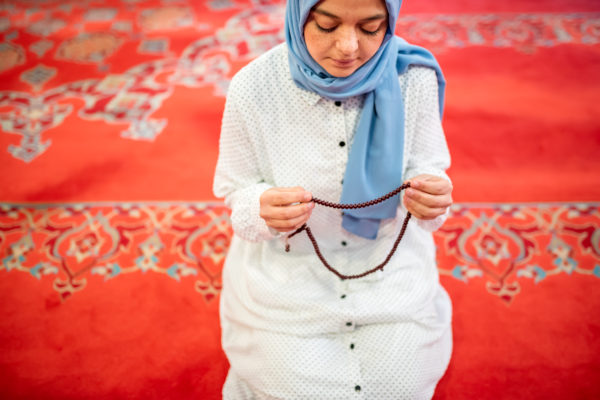As the month of Ramadan is finally upon us, it is important to have a clear plan on what one needs to work on spiritually and mentally. It would be a shame for someone to fast for an entire month, follow the rules of Islam for a month, and then simply revert back to unhealthy habits. One of the reasons we, as Muslims, need Ramadan is because it is a way to set us up for the rest of the year to be better Muslims. We pray daily, attend jummah weekly, and fast yearly; this daily, weekly, and yearly routine is designed to have our minds, bodies, and spirits, in tune with God. For me there are “3 R’s of Ramadan” that can help us truly focus on being better Muslims past Ramadan; Refocus, Recommit, and Reflect. What I aim to do is to use historical examples from the life of The Prophet, to outline times where he himself, had to refocus, recommit, and reflect.
In the book, In The Footsteps of the Prophet: Lessons from the Life of Muhammad, Tariq Ramadan outlines a time in The Prophet’s life known as al-fatra, or The Period of Silence. Up until this point, The Prophet was receiving bits and pieces of revelation, and one day, they stopped. One remembers, during the first revelation on Mount Hira, The Prophet thought he had gone mad or was bewitched. He had to seek the opinion of Waraqah ibn Nawfal(who was a Christian), cousin of Khadidja, who confirmed him as a prophet.[1]
It is narrated by Aisha that, during this time, The Prophet was hurt and that his sorrow was deep. Tariq Ramadan says this time was, “an initiation shaping the Messenger’s spiritual quest.”[2] One can only imagine the torment that went through The Prophet’s mind during this time. In the end, The Prophet never lost faith and was on a cycle of refocusing, reflecting, and recommitting himself to the task he knew in his heart he was destined for, even when uncertainty cloaked his life.
Al- Fatra was a moment in The Prophet’s life that was uncertain and filled with sadness but, not the only one. Historians of religions such as Karen Armstrong, in her book Muhammad: A Biography of a Prophet, writes about The Year of Sadness. In the year 619, The Prophet would go through a series of trials and tribulations.[3] In the year 619, The Prophet’s wife, Khadidja, who was in her sixties died. [4] Tariq Ramadan says that Muhammad’s marriage to Khadidja had been a sign of God’s protection and security.[5] Khadidja had been Muhammad’s only wife until this point in history, and his greatest supporter. Not even Abu Bakr or Umar would be able to give the type of support that Khadidja gave The Prophet. [6]
In the same year, The Prophet’s uncle, Abu Talib also died. The Prophet had immunity among the Quraysh because of his uncle, this was another blow to The Prophet. According to Sunni traditions, whilst taking his last breaths, The Prophet begged his uncle to profess the faith of Islam but, it was not meant to be, Abu Talib would die a non-Muslim. The Prophet Muhammad, Messenger sent to mankind, was unable to deliver one of his closet family members to Islam.
With this heavy heart and deep sadness, The Prophet with every trip he made to the Kaba and prayed during the night, was able to refocus, reflect, and recommit himself to his task at hand. One night while The Prophet was standing at the Kaba late at night, he felt deeply tired and fell asleep at the Kaba. It was then that Angel Gabriel came to him and took him on a journey from Mecca to Al-Aqsa in Jerusalem. It was here that The Prophet met with other Prophets such as Abraham and Moses (some scholars also say Jesus). The Prophet was then taken past the seven heavens to the “Lotus of the Utmost Boundary”, where God gave The Prophet instructions on the establishment of five daily prayers. This was not just a moment for The Prophet but, for Muslims in general. Until this point Muslims prayed facing Jerusalem shortly after the Night Journey, Muslims would face The Kaba. [7] The young Muslim community would now have a new focus and commitment to Mecca even if expelled from the city for a brief moment.
During Ramadan, our everyday lives do not stop. Many of us will still be a very demanding and time crunched schedule while fasting. The hunger pains will be very real, the headaches will come, the discomfort will be there, the dryness in our mouths will borderline unbearable. Through out the day, months, and year, our souls become hungry, uncomfortable, and dry. This is why salaah, jummah, and Ramadan are essential to Islam. Ramadan is a time when we can refocus, recommit, and reflect on key principles while worshiping. If it helps keep a journal with you to record your thoughts through out the day. Open the Qur’an in the mornings and reflect on a verse for the day. Reach out to your friends and family and make sure they are in good spirits. InshaAllah, the lessons learned during this Ramadan are lessons that can held throughout the year.
References
[1] Tariq, Ramadan, In the Footsteps of the Prophet: Lessons from the Life of Muhammad, (Oxford, Oxford University Press, 2007), 33.
[2] Ramadan, In the Footsteps of The Prophet, 33.
[3] Karen, Armstrong. Muhammad: A Biography of a Prophet, (New York, HarperSanFransico Publishing, 1993), 135.
[4] Armstrong, Muhammad, 135.
[5] Ramadan, In the Footsteps of the Prophet, 67.
[6] Armstrong, Muhammad, 135.
[7] Ramadan, In the Footsteps of The Prophet, 73.





